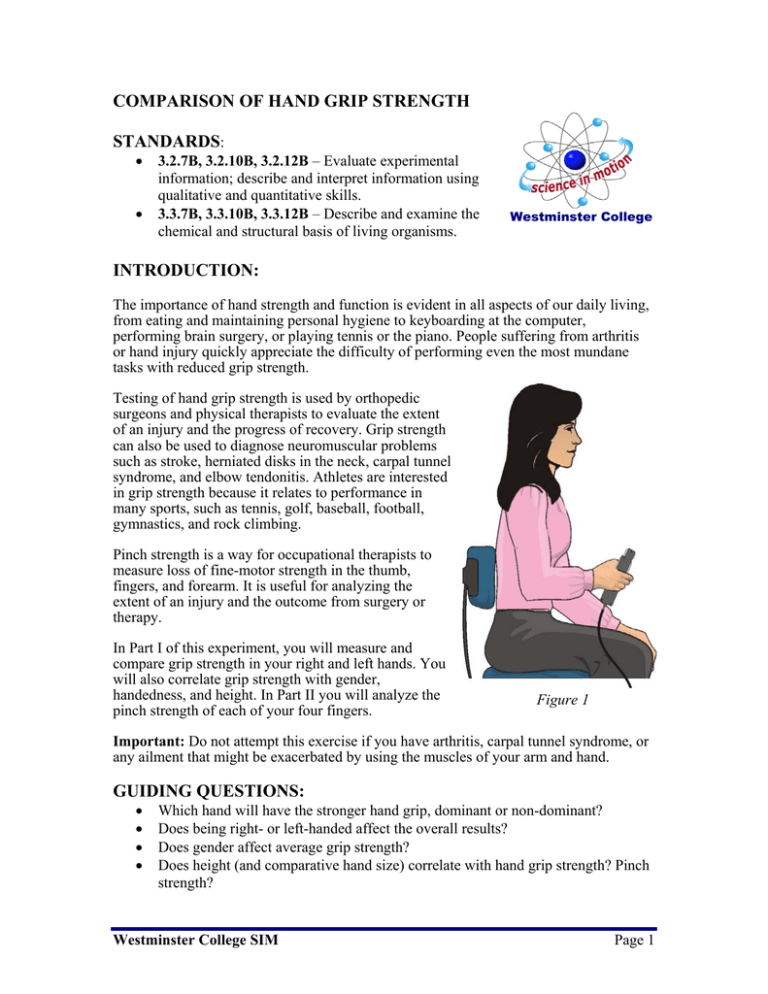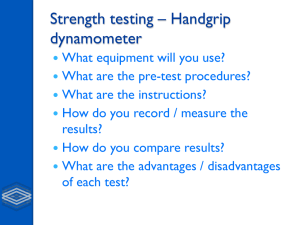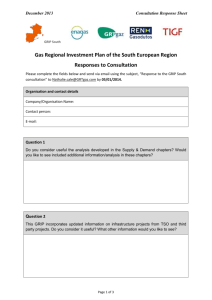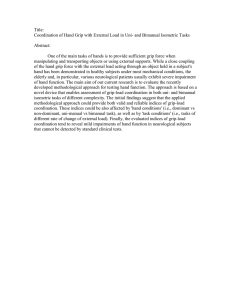COMPARISON OF HAND GRIP STRENGTH STANDARDS
advertisement

COMPARISON OF HAND GRIP STRENGTH STANDARDS: • • 3.2.7B, 3.2.10B, 3.2.12B – Evaluate experimental information; describe and interpret information using qualitative and quantitative skills. 3.3.7B, 3.3.10B, 3.3.12B – Describe and examine the chemical and structural basis of living organisms. Westminster College INTRODUCTION: The importance of hand strength and function is evident in all aspects of our daily living, from eating and maintaining personal hygiene to keyboarding at the computer, performing brain surgery, or playing tennis or the piano. People suffering from arthritis or hand injury quickly appreciate the difficulty of performing even the most mundane tasks with reduced grip strength. Testing of hand grip strength is used by orthopedic surgeons and physical therapists to evaluate the extent of an injury and the progress of recovery. Grip strength can also be used to diagnose neuromuscular problems such as stroke, herniated disks in the neck, carpal tunnel syndrome, and elbow tendonitis. Athletes are interested in grip strength because it relates to performance in many sports, such as tennis, golf, baseball, football, gymnastics, and rock climbing. Pinch strength is a way for occupational therapists to measure loss of fine-motor strength in the thumb, fingers, and forearm. It is useful for analyzing the extent of an injury and the outcome from surgery or therapy. In Part I of this experiment, you will measure and compare grip strength in your right and left hands. You will also correlate grip strength with gender, handedness, and height. In Part II you will analyze the pinch strength of each of your four fingers. Figure 1 Important: Do not attempt this exercise if you have arthritis, carpal tunnel syndrome, or any ailment that might be exacerbated by using the muscles of your arm and hand. GUIDING QUESTIONS: • • • • Which hand will have the stronger hand grip, dominant or non-dominant? Does being right- or left-handed affect the overall results? Does gender affect average grip strength? Does height (and comparative hand size) correlate with hand grip strength? Pinch strength? Westminster College SIM Page 1 Comparison of Hand Grip Strength MATERIALS LabQuest and Power Supply LabQuest Application Vernier Hand Dynamometer PROCEDURES Each person in the group will take turns being subject and tester as time allows. Part I Hand Grip Strength 1. Connect the power supply and the Hand Dynamometer to the LabQuest. Turn on the LabQuest by pressing the oval button at the top left of the device. Choose New from the File menu. 2. On the Meter screen , tap Length. Change the data-collection length to 10 seconds using the touch keyboard. Select OK. 3. Zero the readings for the Hand Dynamometer. Hold the Hand Dynamometer along the sides, in an upright position (see Figure 2). Do not put any force on the pads of the Hand Dynamometer. When the readings stabilize, tap the red Force box and choose Zero from the menu. The readings for the sensor should recalibrate to be close to zero. Figure 2 4. Have the subject sit with his or her back straight and feet flat on the floor. The Hand Dynamometer should be held in the right hand. The elbow should be at a 90° angle, with the arm unsupported (see Figure 1). 5. Select the Graph mode . A graph of Time (s) vs. Force (N) will appear. Have the subject close his or her eyes, or avert them from the screen. 6. The student operating the LabQuest will start data collection by tapping the Start icon . After collecting 2 seconds of baseline data, instruct the subject to grip the sensor with full strength for the next 8 seconds. Data will be collected for 10 seconds. The LabQuest will automatically stop taking data after this time period. 7. Determine the maximum and mean force exerted by your hands during a portion of the data collection period. a. Tap and drag the stylus across the data from 4 s to 8 s. Gray shading should now highlight this portion of the graph. b. Select Analyze → Statistics → Force from the menu at the top of the screen. The minimum, maximum and mean force will appear in the box to the right side of the screen. c. Record the maximum and mean force in Table 1. Westminster College SIM Page 2 Comparison of Hand Grip Strength 8. Store the data from the first run by tapping the File Cabinet icon . 9. Repeat Step 3−8 with the left hand. To display both graphs simultaneously, tap the box and select All Runs. The graph for both the right and left hand will appear on the graph. The statistics for both runs will also be displayed to the right of the screen. 10. Work with your classmates to complete Tables 2−4. Note: In Table 4, round height to the nearest inch. Part II Pinch Strength 11. Tap the Meter tab . Go to the File menu and select New. Tap the gray Length box to the right of the screen and change the data-collection length to 20 seconds. Select OK. 12. Have the subject sit with his or her back straight and feet flat on the floor, holding the Hand Dynamometer along the sides in the non-dominant hand (see Figure 3). Note: No additional force should be placed on the sensor by this hand. 13. Hold the Hand Dynamometer along the sides, in an upright position. Do not put any force on the gray pads of the Hand Dynamometer. When the readings stabilize, tap the red Force box and choose Zero from the menu. The readings for the sensor should recalibrate to be close to zero. Figure 3 14. Select the Graph mode . A graph of Time(s) vs. Force(N) will appear. Have the subject close his or her eyes, or avert them from the screen. 15. The student operating the LabQuest will start data collection by tapping the Start . Instruct the subject to immediately pinch the end of the sensor between the icon pads of the thumb and forefinger of his or her dominant hand, and hold for 5 seconds. 16. Instruct the subject to switch to successive fingers every 5 seconds. Only the finger tips should be used in this part of the experiment. Data collection will stop after 20 seconds. The graph should look similar to the one in Figure 4. 17. Determine the mean force applied during each pinch. a. Tap and drag across the first plateau on the graph, to select the data representing the pinch strength of the thumb and index finger (see Figure 4). b. Select Analyze → Statistics → Force from the menu at the top of the screen. The minimum, maximum and Figure 4 Westminster College SIM Page 3 Comparison of Hand Grip Strength mean force will appear in the box to the right side of the screen. Record the mean pinch strength to the nearest 0.1 N in Table 5. c. Choose Statistics from the Analyze menu to turn off statistics. d. Select the data in the second plateau, representing the pinch strength of the thumb and middle finger. Choose Statistics from the Analyze menu. Record the mean pinch strength to the nearest 0.1 N in Table 5. e. Choose Statistics from the Analyze menu to turn off statistics. f. Repeat this process to obtain statistics for the remaining two pinch strengths. REFERENCE: Diana Gordon and Steven L. Gordon, M.D. 2005. Human Physiology with Vernier. Experiment 8: Blood Pressure and Exercise. Vernier Software & Technology. Beaverton, OR. Pp 16-1 – 16-6, 16-1T – 16-3T. CREDITS: The lab was adapted and revised by Dr. Stephanie Corrette-Bennett. Westminster College SIM Page 4 Comparison of Hand Grip Strength DATA SHEET Name: _______________________ Group: _______________________ Date: _______________________ Table 1−Individual Grip Strength Data Maximum force (N) Mean force (N) Right hand grip strength Left hand grip strength Table 2−Class Grip Strength Data Average mean force (N) Males (dominant hand grip strength) Females (dominant hand grip strength) Table 3−Class Grip Strength Data Average mean force (N) Right hand Left hand Right-handed individuals Left-handed individuals Table 4−Class Grip Strength Data Height (rounded to nearest inch) Average mean grip strength of dominant hand (N) 1.52 m (5’) or below 1.55−1.63 m (5’1”−5’4”) 1.65–1.73 m (5’5”−5’8”) Westminster College SIM Page 5 Comparison of Hand Grip Strength 1.75–1.83 m (5’9”−6’) 1.85 m (6’1”) and above Table 5−Individual Pinch Strength Data Mean force (N) Dominant hand index finger Dominant hand middle finger Dominant hand ring finger Dominant hand little finger DATA ANALYSIS 1. Is there a difference in grip strength in your dominant and non-dominant hands? Are you surprised by the result? 2. Examining the data in Table 3, does there appear to be a correlation between “handedness” and grip strength? Are the results similar for right-handed and left-handed people? 3. Is there a difference between the grip strengths in the different categories of height for which data was collected in Table 4? What conclusion can you draw about the relationship between height and grip strength? Westminster College SIM Page 6 Comparison of Hand Grip Strength 4. Does gender play a more significant role in grip strength than height? than “handedness?” 5. Using the pinch strength data in Table 5, describe the difference in strength between fingers. Where is the difference the largest? 6. List at least two possible reasons for the differences you see between the pinch strength of the first two fingers and the second two fingers. In your answer consider actions of the hand and musculature (Use an anatomy textbook or atlas to view the muscles of the forearm and hand). Westminster College SIM Page 7




